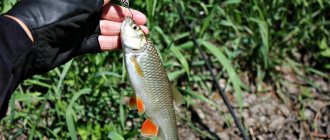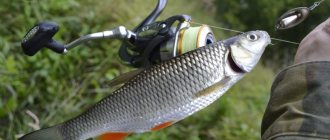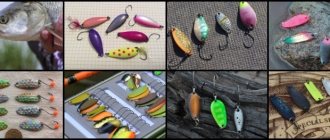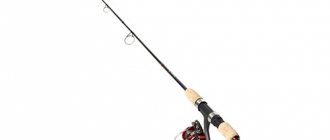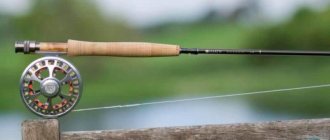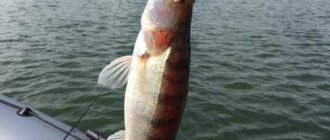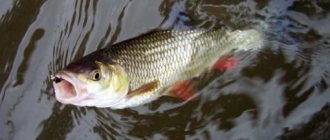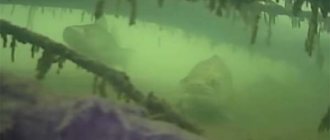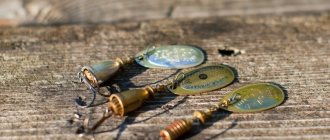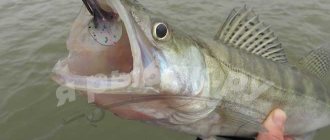Technique for catching chub using feeder tackle
Feeder is an improved version of bottom gear. Her fans catch many types of fish. Among them there is also a chub. Its unexpected and decisive bites motivate anglers to purposefully hunt for fish. Catching chub on a donk pleases with its high efficiency. When catching it, a tackle with a feeder is used, which allows you to catch both in still water and in fast currents.
Feeder - an improved version of bottom gear
Winter fishing for chub on the river with a feeder
In winter, you can go fishing for chub on the river using a feeder. For example, this is what the famous fisherman Paul Elt does. Here's what he recommends doing in winter on an ice-free river or on a section of the river not covered by ice. Fishing can also be carried out at negative air temperatures.
Equipment (diagram) for catching chubs in winter on a feeder
The equipment that is used for winter fishing on the river using a feeder is as follows.
This is a light rig and requires a light feeder or picker with a sensitive tip to control it.
- Leash is not used
- The main line has a strength of about 2.2 - 2.5 kg.
- The load is sliding on a lead leash, the length of which is 7.5 cm.
- The weight of the load is usually 4 - 6 grams, but it is easy to select according to the strength of the current and the distance.
- The movement of the load is limited by a pair of stoppers and a pair of beads
- A large hook is used under the crawler.
By moving the stopper along the line, you can adjust the length of the final section of the line. Usually this segment is made longer so that the bait plays attractively and for a long time in the current before sinking to the bottom. But for fishing in cramped conditions, you can make the lead part shorter.
When is the best time to catch chub?
Paul Elt claims that chub are better caught when frosty weather with persistent high pressure lasts for a long time (several days or even weeks). This season should not be missed and you should go fishing for fattening chub on an unfrozen river.
Fishing tactics and catching techniques
But fishing tactics must correspond to the behavior of sluggish fish in cold water. The fisherman suggests doing the following.
Bait - the crawler is cast further away or to the other shore. After this, every 5 minutes you need to tear the bait off the bottom with the tip of the rod, after which the equipment will move a short distance under the influence of the current.
In this case, the arc of the fishing line must be large enough so that the current does not constantly tear off the light load.
With occasional movements, the selected water area is gradually explored. But you need to be alert, as bites always come unexpectedly and occur anywhere.
In winter you can fish with a feeder on a non-frozen river, and at the same time...
Special baits for winter chub fishing
In addition to the cut chub, which releases a lot of smell into cold water, the fisherman recommends using baits based on cheese for catching chubs in winter.
It is very effective for chub in cold water, and it was on a cheese bait with a feeder that the fisherman caught 14 chubs during one winter fishing trip, with some individuals weighing up to 3 kg.
Baiting a chub using cheese is done as follows.
The cork ball is attached to the hair near the hook. The ball is coated with plastic cheese, which you can make yourself from cheese, milk protein powder and water. Another option is regular cheese spread mixed with bread.
The peculiarity of fishing with cheese is that it should lie in one place longer than a cut worm, since the odor release from the cheese is less.
In promising places, the chub can be fed with dough balls, but the bait should be minimal in winter.
In addition to the feeder, you can also use a fishing rod with drifting equipment to catch winter chub. True, at temperatures below 0 degrees, it will not be easy to achieve normal operation of the wiring harness, since the coil and rings will freeze. But biting a winter chub weighing more than 1 kg on maggots forces one to overcome even less difficult difficulties...
Habitats
It is recommended to look for chub on the current. It can be caught on rivers of any width. Cool and clear water attracts fish. Here she visually observes her prey. Places that need careful fishing:
- whirlpools;
- areas with fast currents;
- cliffs;
- eyebrows;
- river turns;
- the boundary between strong and weak currents.
Places with overhanging trees or bushes deserve attention. They constantly drop larvae and small insects, which are considered a real delicacy. The instinctive habit of fish to feed on insects allows you to visually identify promising places on the river. Hunting for its prey, the fish freely rises to the surface of the water and just as willingly sinks to the bottom.
Good locations include sandbanks. Here it is convenient for the fish to pick up food that has fallen into the water. When using a bait for chub in winter, look for fallen trees and snags. There is always food here that attracts fish.
Chub habitats
Omnivorous fish will happily taste baits of animal and plant origin. The list of delicacies is quite large. Often an underwater hunter gives preference to certain baits, depending on the weather, conditions, and water temperature. The fisherman has to carry different types of bait with him. The most popular and effective of them:
- maggot;
- worms;
- frogs;
- dragonfly larvae;
- beetles;
- peas;
- corn;
- live bait;
- bread crust;
- moths, grasshoppers and other insects.
Peas for catching chub
It is recommended to offer different baits at the same time, casting several rods with rigs. Some attachments cannot be used all year round. Experienced fishermen use seasonal baits. With the onset of the active season of some type of insect, the fish switches to appropriate nutrition. Catching chub in the spring on a donk begins when the cockchafer flies out. It becomes the best bait. But don’t forget about backup options that can please you with a good result.
Baits
Omnivorous fish will happily taste baits of animal and plant origin. The list of delicacies is quite large. Often an underwater hunter gives preference to certain baits, depending on the weather, conditions, and water temperature. The fisherman has to carry different types of bait with him. The most popular and effective of them:
- maggot;
- worms;
- frogs;
- dragonfly larvae;
- beetles;
- peas;
- corn;
- live bait;
- bread crust;
- moths, grasshoppers and other insects.
Peas for catching chub
It is recommended to offer different baits at the same time, casting several rods with rigs. Some attachments cannot be used all year round. Experienced fishermen use seasonal baits. With the onset of the active season of some type of insect, the fish switches to appropriate nutrition. Catching chub in the spring on a donk begins when the cockchafer flies out. It becomes the best bait. But don’t forget about backup options that can please you with a good result.
Read more
How to choose the right feeder rod?
Briefly about bait
The choice of bait when fishing for chub on a feeder depends on the season. But there are “working” baits that can always please you with a good result:
- frogs. Use small frogs. They give hope of catching a large specimen;
- The larvae of beetles and flies are considered a real delicacy. But they have a drawback - small fish often bite;
- dragonfly larvae, which appear in the spring, ideally attract individuals of different sizes;
- Peas and corn are used when there are large numbers of small fish. Vegetable baits reduce the likelihood of them being caught, giving hope for a larger catch. The use of canned baits is allowed;
- insects. Dragonflies, grasshoppers, flies are the best baits for summer fishing;
- An effective bait for chub in the spring on a donk - the chafer, which is brown in color, is used for fishing in May–July. The attachment allows you to catch a chub of impressive size on a donk.
May beetle for catching chub
Chub bait
When catching chub on a donk or feeder, you can use various baits. The chub itself is an omnivorous fish and feeds on a wide variety of foods. Both animal and plant foods are suitable for catching chub. It is unlikely that it will be possible to list all the baits that can be used to catch chub on a donk. There are actually a lot of them.
The most common and effective baits for chub are:
- worms (dung worms, earthworms, crawling worms);
- maggot;
- small frogs;
- beetles (preferably caught near a pond)
- dragonfly larvae;
- corn;
- peas;
- bread (usually crust is used);
- live bait;
- insects (grasshoppers, dragonflies, moths).
Grasshopper
Chafer
Zywiec
frog
Worm
The baits listed are the most common baits for chub fishing. To find out which one works best on your pond, you can put different baits on each of your gear and when you find out which one works better, put it on all the gear. Another important point in choosing bait is the season. What worked well in the spring may have much less effect in the spring, and it is not always possible to find some baits all year round. Remember, you can’t get hung up on any one bait; what didn’t work for you a month ago may be the best bait right now.
The same applies to various bodies of water. A beetle works well on one river, and live bait on another. You may have a favorite bait that will produce success, but never rule out backup options.
Briefly about bait
- Frog is an excellent bait for large chub. On some rivers, the chub bites on it reluctantly and rarely, but if the chub in the river accepts the frog, then you will often come across trophies.
- Larvae. Various larvae are used to catch chub on a donk. These can be beetle larvae (May beetles), bark beetles, maggots and others. The downside of these attachments is that when using them, small things will get in the way.
- the dragonfly larva separately. This is one of the best baits for chub in spring and early summer. When catching chub on a donk in April, May, and June, there is no better bait to be found.
- Peas, corn. Quite a good nozzle that cuts off small things. Easy to store and prepare. You can use canned peas and corn. However, they are slightly inferior in catchability to natural, steamed peas.
- Insects. The chub bites well on grasshoppers and dragonflies. Moreover, it’s hard to even imagine catching chub in the summer (June, July, August) without bait such as a grasshopper, fly, etc.
- Bug. Among other insects, let us highlight the beetle. This bait is great for catching large chub. Catching chub on a donk with bait such as a cockchafer promises the capture of fairly large specimens.
When catching a chub on a donk or feeder, using a May beetle or dung beetle as bait, it is necessary to tear off their upper wings, which create a kind of shell for the beetle. Then the beetle’s catchability will be significantly greater.
Chub fishing time
Catching chub in the spring on a donk begins with the onset of warm days. In April-May, fishermen already go looking for it. But the peak of fish activity occurs in the summer months. Increased activity is associated with the appearance of a large number of insects and their larvae.
During the day, the fish stays near the surface of the water, collecting fallen food. When your bait is found on the bottom, it will go down after it without hesitation. At night, the fish are mainly at the bottom. Given this feature, anglers often go out for night fishing. In spring and autumn, the fish sticks to the lower layers.
Habitat and habits of the chub
Promising places for catching this fish in May can be found everywhere, including close to big cities. Quite often it can be found in reservoirs where there are pronounced rock changes. Usually the largest individuals stand behind large boulders. A chub can weigh up to eight kilograms, but such specimens are very rare. Basically we are talking about catching individuals weighing three to four kilograms.
It is not recommended to stand up to your full height, much less make noise, as this fish is quite cautious. Spring chub fishing on a feeder is considered one of the most sporting types of fishing that is possible on our reservoirs. Commercial fish live both in lakes with stagnant water and in fast-flowing rivers.
Features of chub fishing in November
With the arrival of autumn, many fish intensify their bite, trying to accumulate more energy before the onset of winter. The chub is also no exception. However, if in September and early October it is caught well with float gear, then closer to mid-October you can forget about float fishing. Now the main equipment for catching chub is bottom tackle and spinning rod. Chub fishing in October
, is characterized by the fact that this fish, unlike September chub, is no longer caught in the mornings and evenings. Its fishing occurs in the afternoon, when the water in the reservoir warms up to some extent. At this time, it is already useless to look for chub in the cold rapids; you should look for this handsome river in calmer places.
The main topic of this article is chub fishing in November
, so we will look more carefully at how the process of catching this fish occurs in November.
Let's start with the fact that November is not the best time for chub fishing. And of course hopes for big catches of chub, in this last autumn month it’s not worth it. However, it is quite possible to catch a chub in the pre-winter period, although the chances are not so many in the central regions, but they are quite high in the more southern regions. There, the water cools more slowly and the rivers become covered with ice later, or even not at all, it all depends on the winter. However, it should be remembered that in November the chub is little predictable, and this is associated with difficulties in catching it. However, for experienced fishermen who know perfectly well the habits of the chub, its habitat, and places of possible migrations, chub fishing in November
no problem.
Long-term practice of chub fishing shows that this fish becomes very active in November on sunny, clear days, when the thaw begins. As a rule, it is recommended to start fishing for chub no earlier than 10 a.m., so that the water has at least a little time to warm up. Sometimes the chub begins to bite only at lunchtime. However, it often happens that active chub biting can begin 2 hours before lunch. Then the chub bite may be interrupted for several hours and resume again only at 2 or 3 o’clock in the afternoon.
It often happens that an angler goes out to catch chub at lunchtime and, after waiting a couple of hours, rolls up his gear and leaves the reservoir, although it is likely that if he had stayed 10-15 minutes longer, he would have gotten a decent bite. You also need to know that the closer winter is and the worse the weather, the more the activity of the chub decreases and the less chance of catching this fish. That is, everything mainly depends on the weather and the characteristics of the reservoir. After all, there are reservoirs into which warm water is discharged, for example from hydroelectric power plants. And the situation there may be radically different. However, even in ordinary reservoirs, if the autumn is warm, chub can be caught until the end of November. However, in the southern regions, in the Kuban, in the Rostov region, chub fishing in November
completely normal thing.
And in non-freezing reservoirs they catch chub in the month of January. Thus, successful chub fishing in late autumn
is very dependent on the climate zone.
Where to look for and catch chub in late autumn?
When late autumn arrives and pre-winter cold sets in, the habits of many fish, including chub, change. So, for example, if in summer the chub preferred shallow depths and areas of the reservoir with fast currents, then in late autumn everything changes radically. In November, the chub's main food becomes fry; it goes to deep holes for the winter. The chub rushes into them.
Therefore, the fisherman needs to get to the desired depth, and this is very important. 15-20 cm further or closer and all efforts will lead to nothing. In November they look for chub both in pits and at the exits from them; there are good chances of finding chub in deep pools. It is also worth paying attention to areas of the reservoir with a sandy or rocky bottom. These areas are very attractive for chub. At this time, the chub prefers to be in areas with weaker currents. Usually these are various backwaters, backwaters, or simply wide areas of a reservoir with a slow current. Snags and other natural shelters under water can also be promising places for catching chub in November. As a rule, experienced fishermen have their own time-tested points; they usually start fishing these places first as soon as they get to a given river.
It is quite natural that chub fishing in November
in such places it often pleases fishermen with good and or not so good catches. However, even in such places misfires can occur. It also happens that, for example, 3-4 days ago a fisherman here had a good catch and the chub bit quite well, but today they are silent, no matter what you do. What could have caused this? The fish simply could have moved to other areas and then you can try to look for it in other places of the river, which were probably previously considered unpromising by the fisherman, or the chub for some reason is simply not active, and where you don’t look for it, there will still be no bite.
It’s worse if the angler gets to the reservoir for the first time and doesn’t yet know where exactly to catch chub. Then he will have to additionally spend time searching for areas where there are chub. Chub fishing in November
, as indeed at any other time, requires a constant active search for prey, selection of the right baits, experiments with playing with baits and baits, mistakes and correct actions.
What baits to use for catching chub in November
The peculiarities of catching chub in November are that you need to choose the right bait and bait, and this is not an easy task, because in the pre-winter period the chub is very capricious. If you choose the right bait, then there is a high probability that the fishing will be successful, but if the bait is chosen incorrectly, then you may not see a single bite.
At the same time, the difficulty lies in the fact that it is simply impossible to specify the bait, its model and manufacturer, and then begin to successfully catch chub with its help. On any body of water, in different seasons and in different weather, you need to learn to select bait right while fishing. It should be assumed that the tastes of fish, as well as its mood, can change with the weather and temperature. Sometimes several times a day.
The optimal baits for catching chub in late autumn are wobblers, spinners, and jig baits. These spinning lures most often bring success during the November fishing period.
What do you need to know about the baits used for chub fishing? As a rule, chub prefer baits of natural colors. Lures that are dark in color, brown, dark purple, dark green and black often activate the chub’s bite. It happens quite rarely that a chub begins to prefer baits that have bright colors.
Catching chub in November with a wobbler
, just like in spring or summer, can give good results. However, such baits should be selected with a not too active game, taking into account the fact that in the pre-winter period the fish are not very active. Rotating spoons are also effective for catching chub in November. Jig baits are used for catching chub with a stepped retrieve.
Happy fishing!
Details and purpose of equipment
Since the type of fishing in question originated in Great Britain, English rods are considered the most optimal for it. A length of 13 feet will be sufficient.
Installing a feeder in feeder fishing can look different:
- Gardner's loop. Sensitive and versatile equipment. It is easy to install;
- Asymmetrical loop. Well suited for fishing in fast-flowing waters;
- Symmetrical loop. Used in weak currents;
- Helicopter. The feeder is installed at the very end of the fishing line;
- Anti-twist. A special tube is used through which the main line passes. Please note that additional elements may scare away the cautious chub;
- Inline. The movement of the feeder here is limited by a stopper, and a carabiner is used to slide it;
- Combine. The feeder is mounted to the tube using a piece of fishing line, which helps preserve the main equipment in case of breakage.
One of the most practical ways to install it is a symmetrical loop:
- Before installation, you need to wet the fishing line to make the knots stronger.
- A loop is made on the main line at a distance of thirty centimeters.
- Stepping back from this loop 10-15 centimeters, a second loop is knitted.
- Then the feeder is mounted through a swivel.
- To prevent the feeder from sliding along the fishing line, it must be fixed.
- The remaining end of the fishing line is intended for a leash, where the hook with bait will be attached.
To equip the feeder, it is better to use braided fishing line, as it makes it easier to explore all the nuances of the bottom. Also, to clearly perceive the bottom relief, a marker weight is used; it is specially made in such a way that you can quickly find your bearings. This is facilitated by the spikes that are located on the sides. For a flexible and lightweight feeder rod, a marker weight of 50-70 grams will be sufficient.
Effective bait and types of bait
To increase the success rate for successful fishing on a spring day, and accordingly the amount of catch, you need to resort to proven methods of feeding chub. To prepare such bait that the fish will be delighted with, you will need the following components:
Photo 2. You can use soil for seedlings.
Photo 3. Set of bait components.
The whole mass is mixed with the gradual addition of water, and then infused for ten to fifteen minutes.
You can put five or six bloodworms on the hook; bait in the form of a red worm is also good. There is an effective bait method called a “sandwich”. It involves planting a piece of a worm and a couple of bloodworms along with it. Interestingly, fishing practice confirms that it makes sense to use this method in the absence of bites, since positive changes are often observed when using it. You can also catch chub using maggots.
Tactical techniques and fishing methods
When fishing for chub on a feeder tackle, they try to make a large number of recasts in order to remove debris accumulated on the line and check the integrity of the bait. It is very easy to determine the fishing distance; you need to do a few simple steps:
- We clip the fishing line.
- We count the number of revolutions.
When starting to feed, we must not forget about the rule of five feeders. At the beginning of the process, you should feed the fish well. To prevent the animal bait from running away, we place the selected treat on the hook, and then just fill the feeder.
If the coastal edge is located significantly close or it is felt that the specimen caught on the hook is quite large, it is necessary to prepare a landing net in advance so as not to miss the spring and much-awaited catch.
When fishing in a current, it is best to use a so-called asymmetrical loop. It is not difficult to prepare, so installation can be done both at home and directly at the fishing site. It is mounted as follows:
- a small loop is held in place where the swivel and reins will be attached;
- twisting is done (about 20 turns to form a kind of pigtail);
- a loop is knitted with an indentation of twelve centimeters;
- the “pigtail” is fixed and a bead is attached, which will act as a buffer and help prevent the loop from “breaking”;
- All that remains is to attach the feeder itself to the swivel.
Attention! It is imperative to take into account an important nuance, which is to ensure the free movement of the feeder, for which it is necessary to shift the main line by one centimeter and make another strong loop. Taking such measures will help avoid unnecessary tangling of the fishing line, and along with it, loss of time.
Having done everything correctly, you won’t have to wait long for a bite, and the end result of feeder fishing will exceed even your wildest expectations! It is better to release small specimens so that they grow up and then delight us with breathtaking fishing!
Fishing in November with spinning rod
Experience shows that the most effective way to catch chub is in November using a spinning rod. A spinning rod is selected for specific fishing conditions. You will have to carry out the wiring along the bottom or above the bottom surface, and the spinning equipment is selected in accordance with the fishing conditions. For such fishing conditions, Texas or Carolina rigs are suitable. You can also use a Tyrolean stick.
When fishing in clear water, it is important not to reveal yourself on the shore. A chub is unlikely to be tempted by bait on rough equipment, and will not bite in places where additional noises that are unnatural for its usual habitat appear.
Lures for chub in November
Before freeze-up, good results can be achieved by jig fishing. Twisters, vibrotails and other silicone analogues of aquatic inhabitants of a particular reservoir are used as bait.
Fast-sinking wobblers and spinners up to 6 cm in size work well. Uniform retrieving with periodic pauses usually provokes the chub to bite.
You should check the chub's reaction to silicone fish. Its selection is carried out according to the signs of small fish scurrying in the reservoir. The weight on such baits allows you to perform retrieval, as when fishing with a jig.
